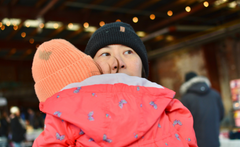
Lunar New Year in 2023 starts on January 22, 2023! Lunar New Year is tied to the Chinese lunar calendar, whose parameters were set according to the lunar phases as well as the solar solstices and equinoxes.
Every year, the Chinese calendar is represented by one of twelve zodiac animals: the rat, ox, tiger, rabbit, dragon, snake, horse, goat, monkey, rooster, dog and pig. Since there are twelve animals in the Chinese zodiac, each animal repeats every 12 years. Learn about your zodiac animal and horoscope for 2023! If you're curious, you can also compare to the 2022 horoscopes.
The Chinese zodiac remains popular throughout China and much of Asia. It’s an important part of everyday life and used to determine your fortune for the year, marriage compatibility, career path, best times to conceive, and more.
2023 is the year of the Rabbit. The sign of Rabbit is a symbol of longevity, peace, and prosperity in Chinese culture.
Celebrate The Lunar New Year With 50% off Jenny & Andy's Numbered Cubes!
From January 20 to February 5, 2023, get 50% off our Organic Plush Number Cubes. Hurry, while supplies last!
Lunar New Year In China, Vietnam, South Korea, and Malaysia
Lunar New Year is the most important holiday in China, but it’s also celebrated across East Asia. Keep reading to learn about how Lunar New Year is celebrated in:
China
As mentioned, Lunar New Year is the most important holiday in China, where festivities can last 16 days, starting on the first new moon and lasting until the first full moon of the lunar calendar.
Customs

On New Year’s Day, elders give red envelopes – known as Hóngbāo in Mandarin – to children or unmarried people, a tradition that evolved from the practice of giving coins to ward off evil spirits.
Street festivities you might see include lion dances, fireworks, and firecrackers to ward off evil. Decorations are decked out in red and gold, symbols of good luck, wealth and prosperity.
There are also taboo activities around New Year. For example, buying shoes during Lunar New Year is a no-no, as the Chinese word has a negative meaning. At the start of the New Year, washing or cutting your hair is also bad luck as it may wash or cut away good fortune that has attached itself to your hair.
Food

Fish is a traditional New Year dish. The Mandarin word for "fish" (Yú /yoo/) sounds like 'surplus' and is believed to bring in a surplus of wealth for the New Year.
Chinese dumplings resemble Chinese gold ingots. Legend has it that the more dumplings you eat during New Year celebrations, the more money you’ll make in the New Year.
Oranges are very important to serve and eat during Lunar New Year. Its roundness is symbol of completeness and their bright colour also symbolizes gold a colour of good luck and wealth.
Noodles are a must to eat during Lunar New Year and should be served uncut as a symbol of longevity.
Vietnam
Vietnamese Lunar New Year is known as Tết Nguyên Đán in Vietnamese, or Tết for short. It is the most important festival that marks the arrival of spring in Vietnam.
Tết celebrations can range from 3 days and continue for up to one week. The festival is split into 3 parts: the day before New Year’s Eve, New Year’s Eve, and New Year’s Day.
Customs

(photo via: Viet Vision Travel)
Preparations usually start a week before Tết. Vietnamese families prepare by cleaning their homes, representing the cleansing of bad luck from the previous year and making room for the coming of the New Year. Cleaning up ancestors’ shrines and decorating the altar of ancestors with flowers, fruits, and food offerings are also traditional customs.
An important ritual involves the first person to enter a Vietnamese house after midnight, known as người xông đất. The Vietnamese believe that the first person to visit their home in a new year can affect their fortune for the rest of the year, so no one enters a house on the first day unless they have been invited.
Similar to Chinese tradition, Vietnamese elders will also give out money enclosed in a red envelope, called Bao Lì Xì, to the younger generation.
Food

(photo via: Viet Vision Travel)
Bánh chưng is a dish eaten in Vietnam only during Lunar New Year. The tasty treat is made of sticky rice with a meat filling or a bean spread. The sticky rice is then wrapped in banana leaves to keep the inside fresh for the duration of the festival.
Chả lụa is a Vietnamese ham or sausage is often served with sticky rice during Lunar New Year. It’s made of lean pork, potato starch, garlic, ground black pepper, and fish sauce. The pork is pounded into a paste, not ground. Fish paste is then added for flavour.
South Korea
Lunar New Year in South Korea is known as Seollal and is a three-day national holiday. During this traditional festival, Korean people usually visit their families, wear hanbok (traditional Korean clothes), perform ancestral rites and eat traditional foods.
Customs

(Photo via: Korea.net)
Around this time, South Koreans also observe another festival called Jeongwol Daeboreum to celebrate the first full moon of the new lunar year. They perform a ritual called Daljip and build huge bonfires to bring luck for the new year.
Sebae is the most important of all the Korean Lunar New Year traditions. Sebae is the act of kneeling on the ground and bowing deeply so that your hands are also on the ground. Younger people must bow deeply to their elders and wish them a happy new year. This deep traditional bow signifies respect.
During Sebae, elders will present the younger family members with money, but instead of a red envelope, they will use a white envelope, called Pujogǔm, with the name of the recipient written on the back.
Food

(Photo via: Michelin Guide)
The most important dish that is eaten during the Korean Lunar New Year is rice cake soup, known as Tteokguk. The sliced rice cake looks similar to a coin and represents abundance for the year. This soup is made using sliced rice cake and contains meat and other things like seaweed.
Another common food that is eaten during the Lunar New Year is jeon a pancake-like dish that contains green onions and kimchi or seafood.
Malaysia
Lunar New Year festivities last for 15 days, with different traditions done on each day, although only the first two days are public holidays in Malaysia.
Customs

(Photo via: The Star)
During Lunar New Year, people often make offerings of fruits, flowers, and other food to the Jade Emperor, either at the altar in Hokkien that was built specifically for the occasion, or altars built in their own homes, to celebrate his birthday.
It is also customary in Malaysia to give out lucky red envelopes with money, called Ang Pow, to children and unmarried people.
A ritual to help young, unmarried women to find a good husband is to throw tangerines into the sea, while men in boats try to catch them. Sometimes, women would write their phone numbers on the oranges!
Food

(Photo via: Fodor's Travel)
Yee Sang is a special dish served only during Lunar New Year that is fun to both witness and eat. It’s is a salad made with different vegetables, salmon, dumpling wrappers and seasoned with hoisin sauce. People will toss the salad into the air using only their chopsticks. It’s important that it’s all tossed really high into the air to reflect the amount of good luck, health and prosperity they will receive.
From January 20 to February 5, 2023, get 50% off our Organic Plush Number Cubes. What better way to celebrate and teach our little ones about new traditions.
Hurry, while supplies last!
Sources:
- Asia Highlights. Vietnamese New Year (Tet) - 7 Things You Need to Know.
- Asia Society. Seollal, Korean Lunar New Year.
- Fresh Mag. A quick guide to Chinese New Year in Malaysia.
- Histor. Lunar New Year 2022.
- Reader's Digest. What Is the Lunar New Year and How Is It Celebrated.
- Wonderful Malaysia. Chinese New Year in Malaysia.
- 90 Day Korean. Korean Lunar New Year: Everything you need to know about Seollal.





